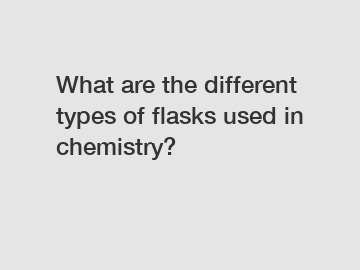Dec. 23, 2023
Packaging & Printing
What are the different types of flasks used in chemistry?
Flasks are an essential tool in the field of chemistry. They are used for a variety of purposes, such as measuring and mixing liquids, holding reactions, and collecting samples. Different types of flasks are designed to serve specific functions and meet particular requirements. In this article, we will explore the various types of flasks used in chemistry and their respective uses.
1. Round-bottom flask (also known as boiling flask):

- The round-bottom flask is one of the most common types of flasks used in chemistry.
- It has a rounded bottom, which allows for uniform heating and the distribution of heat.
- These flasks are often used for distillation, refluxing, and heating of liquids.
- Their design prevents the liquid from splattering or boiling over during the application of heat.
2. Erlenmeyer flask (also known as conical flask):
- The Erlenmeyer flask is another commonly used flask in chemistry laboratories.
- It has a flat bottom with a conical shape and a narrow neck.
- Its tapered sides allow for easy mixing and swirling of liquids, making it ideal for conducting reactions.
- These flasks are often used for titrations, mixing solutions, and culturing microorganisms.
3. Florence flask (also known as boiling flask or boiling bottle):
- The Florence flask resembles a round-bottom flask but features a long neck and a round body.
- It is designed for containing and boiling liquids.
Further reading:- The long neck helps in preventing the splashing of the liquid during the boiling process.
- Florence flasks are commonly used for heating, preparing solutions, and holding liquids that produce gas or require refluxing.
4. Volumetric flask:
- Volumetric flasks are used when precise measurements are required.
- They have a flat bottom, a long neck, and a mark on the neck indicating a specific volume.
- These flasks are used for preparing accurate solutions of a known concentration.
- The narrow neck of the flask enables the precise addition of liquid until it reaches the mark, ensuring the desired volume.
5. Filtering flask:
- The filtering flask, also known as a Buchner flask, is designed specifically for use in filtration setups.
- It has a flat bottom, a sidearm, and a short neck with a ground glass joint.
- The sidearm allows for the attachment of a vacuum source, creating suction to aid in the filtration process.
- Filtering flasks are commonly used in procedures such as vacuum filtration and Buchner funnel filtration.
In conclusion, flasks are indispensable tools in chemistry laboratories, offering a range of functionalities to carry out various tasks. The round-bottom flask, Erlenmeyer flask, Florence flask, volumetric flask, and filtering flask are just a few examples of the different types of flasks used in chemistry. Each flask serves a specific purpose and is designed with features that make it suitable for its intended use. By understanding the characteristics and uses of these flasks, chemists can select the most appropriate flask for their specific applications.
If you have any questions or need further information about the types of flasks used in chemistry, please do not hesitate to contact us. Our team of experts is always ready to assist you with your queries and provide the necessary guidance.
Are you interested in learning more about what is an erlenmeyer flask used for, flask sizes cell culture, roller bottle sizes? Contact us today to secure an expert consultation!
Further reading:Related Articles
If you are interested in sending in a Guest Blogger Submission,welcome to write for us!
All Comments ( 0 )